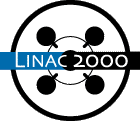
J.S.T. Ng, P. Chen, W. Craddock, F.J. Decker, R.C. Field, M.J. Hogan, R. Iverson, F. King, R.E. Kirby, T. Kotseroglou, P. Raimondi, D. Walz, (SLAC), H.A. Baldis, P. Bolton, (LLL, Livermore), D. Cline, Y. Fukui, V. Kumar, (UCLA), C. Crawford, R. Noble, (Fermilab), K. Nakajima, (KEK, Tsukuba), A. Ogata, (Hiroshima U.), A.W. Weidemann, (Tennessee U.)
The plasma lens was proposed as a final focusing mechanism to achieve high luminosity for future high energy linear colliders [1]. Previous experiments to test this concept were carried out with low energy density electron beams. Here we present results from the SLAC E-150 experiment on plasma focusing of 30 GeV electron and positron beams, with 1.5x10**10 particles per bunch, bunch length of 0.7 mm, and beam cross-section of 7 microns by 3 microns. The plasma lens was created from the ionization of a neutral nitrogen gas jet by the leading portion of the beam pulse: the core of the same bunch was focused simultaneously in both transverse beam dimensions. A factor of two reduction in beam cross-section was measured. The evolution of the beam envelope was also measured and compared with numerical calculations. The synchrotron radiation induced by the strong bending of the beam particles inside the plasma lens was observed for the first time. The effective critical energy was determined to be approximately 30 MeV, corresponding to a bending field strength of 5 Mega-Tesla / m.
[1] P.Chen, Part. Acc., 20, 171(1987).
*Work supported by Department of Energy contract DE-AC03-76SF00515.
Comments or Questions to
linac2000@slac.stanford.edu